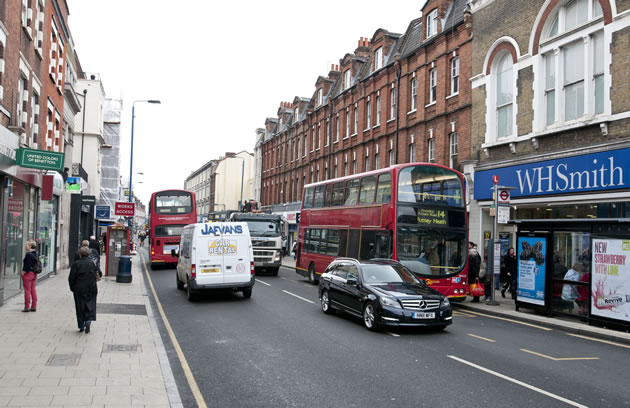Mayor Slammed for Moving ‘Oldest, Dirtiest Buses’ to Route Near Schools
Higher emission buses switched from Putney High Street to elsewhere in the borough

Putney High Street
Sadiq Khan, the Mayor of London, has been asked for an explanation after it was revealed that buses that emit higher levels of pollution and were recently transferred away from routes on the Putney Low Emission Bus Zone have been transferred to another route in the that goes past several schools.
The council’s transport spokesman is calling on London Mayor Sadiq Khan to explain why polluting buses have not been withdrawn from service in the borough as promised, but simply switched to a different route in the area.
Earlier this month the Mayor appeared for a photo opportunity on Putney High Street to announce that the road was to become the capital’s first “low emission bus zone”. He said that the ‘oldest, dirtiest buses’ would be moved from the route to ‘make a big difference to the pollution caused by our public transport system.’
However, zone was made compliant with the emission zone requirement by moving modern buses with cleaner Euro 6 diesel engines that had previously been used on the G1 route running from Streatham to Battersea via Tooting and Clapham Junction to the 424 route which runs from Putney Heath to Fulham via Putney High Street.
In return the G1 route has been given the older single deckers with their more heavily polluting Euro 4 diesel engines that were being used on the 424 route.
Wandsworth Council’s environment spokesman Jonathan Cook said, “If highly polluting buses are being shifted to other routes to achieve a clean bus zone then the Mayor should be open and honest about it. He was quite clear in what he said. He was going to “remove the oldest and dirtiest buses from our streets” but instead they have just been shifted to nearby neighbourhoods so they can belch out noxious fumes there instead.
“And just days after saying all dirty diesel vehicles should be banned from going anywhere near schools these obsolete and polluting buses have been diverted to run past lots more schools and nurseries.
“As a result of this change air quality will be made worse in Battersea, Tooting and Streatham. Simply spreading pollution around is no solution for London.”
According to Wandsworth Council, the change actually means that many more bus movements each day are now being undertaken by the older buses.
On weekdays the 424 runs two buses an hour in each direction, equating to 52 bus movements a day. In contrast the G1 runs four buses an hour in each direction. In total it runs 128 buses each weekday.
Putney High Street is one of the most polluted areas of London. In 2016 it exceeded hourly legal levels of nitrogen dioxide on 1,248 occasions. Under EU rules, the limit shouldn't be exceeded more than 18 times in a year.
When we contacted the Mayor’s Office they directed us to TfL. Leon Daniels, TfL’s Managing Director of Surface Transport, said, “Of the nearly 150 buses that use Putney High Street, around half have recently been replaced as part of our work to improve air quality with Low Emission Bus Zones that will reduce local harmful emissions by over 80 per cent.
“Of the remaining buses, the majority already met the highest Euro VI emissions standard, but around 30 vehicles need to be retrofitted with an improved exhaust system to meet the standard.
“This is taking a little longer than originally thought, so whilst these buses are retrofitted, there is a short term movement of these vehicles to routes outside of Putney. I apologise for the delay. All buses moved from Putney will be fully retrofitted as soon as possible.”
All London buses will meet the Euro 6 emission standard by September 2020 according to TfL
March 30, 2017